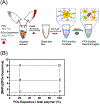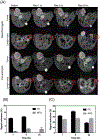Poly(2-oxazoline)-magnetite NanoFerrogels: Magnetic field responsive theranostic platform for cancer drug delivery and imaging
- PMID: 34530163
- PMCID: PMC8665074
- DOI: 10.1016/j.nano.2021.102459
Poly(2-oxazoline)-magnetite NanoFerrogels: Magnetic field responsive theranostic platform for cancer drug delivery and imaging
Abstract
Combining diagnosis and treatment approaches in one entity is the goal of theranostics for cancer therapy. Magnetic nanoparticles have been extensively used as contrast agents for nuclear magnetic resonance imaging as well as drug carriers and remote actuation agents. Poly(2-oxazoline)-based polymeric micelles, which have been shown to efficiently solubilize hydrophobic drugs and drug combinations, have high loading capacity (above 40% w/w) for paclitaxel. In this study, we report the development of novel theranostic system, NanoFerrogels, which is designed to capitalize on the magnetic nanoparticle properties as imaging agents and the poly(2-oxazoline)-based micelles as drug loading compartment. We developed six formulations with magnetic nanoparticle content of 0.3%-12% (w/w), with the z-average sizes of 85-130 nm and ξ-potential of 2.7-28.3 mV. The release profiles of paclitaxel from NanoFerrogels were notably dependent on the degree of dopamine grafting on poly(2-oxazoline)-based micelles. Paclitaxel loaded NanoFerrogels showed efficacy against three breast cancer lines which was comparable to free paclitaxel. They also showed improved tumor and lymph node accumulation and signal reduction in vivo (2.7% in tumor; 8.5% in lymph node) compared to clinically approved imaging agent ferumoxytol (FERAHEME®) 24 h after administration. NanoFerrogels responded to super-low frequency alternating current magnetic field (50 kA m-1, 50 Hz) which accelerated drug release from paclitaxel-loaded NanoFerrogels or caused death of cells loaded with NanoFerrogels. These proof-of-concept experiments demonstrate that NanoFerrogels have potential as remotely actuated theranostic platform for cancer diagnosis and treatment.
Keywords: Magnetic field-triggered release; Magnetic nanoparticles; Magneto-mechanical actuation; Paclitaxel.
Copyright © 2021 Elsevier Inc. All rights reserved.
Figures







References
-
- Rudin M; Weissleder R Molecular imaging in drug discovery and development. Nature reviews Drug discovery 2003, 2, 123. - PubMed
-
- Parvanian S; Mostafavi SM; Aghashiri M Multifunctional nanoparticle developments in cancer diagnosis and treatment. Sensing and Bio-Sensing Research 2017, 13, 81–87, doi:10.1016/j.sbsr.2016.08.002. - DOI
Publication types
MeSH terms
Substances
Grants and funding
LinkOut - more resources
Full Text Sources
Medical

